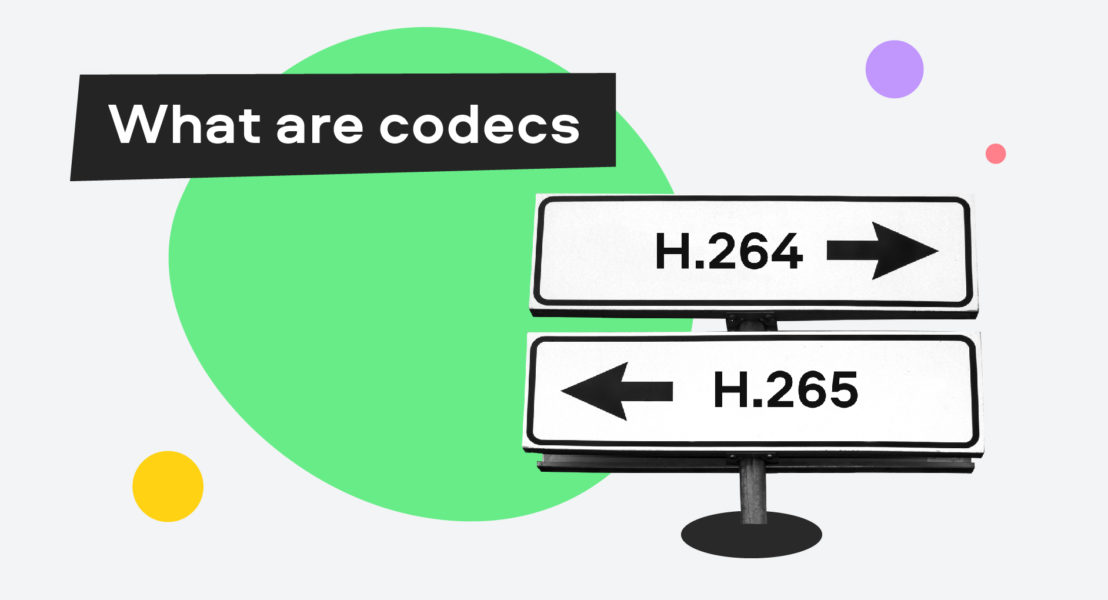We use cookies to improve the services we offer you. By continuing to browse this site, you consent to keep them in accordance with our Privacy Policy.
×We use cookies to improve the services we offer you. By continuing to browse this site, you consent to keep them in accordance with our Privacy Policy.
× 25,115
25,115
 5 min
5 min

If you’re already familiar with editing or outputting video, you’ve probably come across the term codec and wondered what it actually means. We’re here to help you clear things up and also answer one of the most frequently asked questions received in our support center.
A codec is a compression technology that consists of two components – an encoder to compress files, and a decoder to decompress them. That’s why we call it codec – the term is a combination of the words code and decode (co/dec).
Why do we need codecs anyway? Because video and audio take up a lot of storage space. To make this manageable, to be able to stream multimedia smoothly, and to speed uploads and downloads, it’s useful to be able to make the files smaller – in other words, compress them. Otherwise, video and audio downloads would take three to five times longer than they do now.
Without codecs, neither Netflix and chill nor FaceTiming would be possible.
Video codecs can be divided into two groups:
Let’s take a closer look at the most common ones as well as those that are not so popular but that you need to know about.
The majority of encoding output today takes the form of h.264 files, also referred to as AVC (Advanced Video Coding). This is the most commonly used video codec. It provides a good bitrate and helps to keep high-quality video files relatively small. It is very widely supported and you can be confident you will rarely run into any support issues using the H.264.
The successor to H.264, HEVC stands for High Efficiency Video Codec. This codec has a compression rate almost double that of h.264. This means that a file encoded with HEVC is going to be at least 50% smaller than a file encoded in AVC. This is extremely beneficial for resolutions above 2K as well as video streaming.
The downside of HEVC is that it’s much more complicated to encode, requiring triple the resources for the video to be prepared for playback. It is a proprietary codec and has a royalty associated with its usage. Although the adoption of HEVC is growing, after five years it’s not nearly as popular as its predecessor.
The main reason why the adoption of h.265 has been so slow is the mess of its licensing scenario.
Unlike h.264, which has 1 patent pool, h.265 has 3 patent pools. Each of these three pools has its own patent licensing strategy which varies for different types of patent licensor and device type. But that’s not the only problem. These three patent pools don’t include all of the IP owners but only one-third of them! That means that, even if a company licenses from all three pools, it will still be at risk of challenges from other IP owners.
There’s no clear licensing model to let commercial companies use h.265 safely. This lack of clarity has hindered the adoption of the h.265 standard. As a result, some primary browsers (Chrome, Firefox) have no support for it at all and some (Edge) provide only partial support. Because of this, many content providers have stuck with h.264 because at least they know it will always work.
So now you see why we don’t use it at Movavi: because it will make our products more expensive, put our company at risk, and any videos you save with h.265 won’t be playable on some devices or browsers.
This year, the successor to H.265 was finalized. The developers of this standard promise 50% more efficiency. Let’s just hope that their licensing policy won’t be as aggressive and complex as HEVC’s.
This codec was developed by Google as a royalty-free open-source codec. Originally it was used for YouTube, because it also reduced bitrate 50% more than its predecessor, VP8.
It’s good for high-resolution videos and live-streaming, but harder to decode and less widely supported than h.264.
This open-source royalty-free codec was developed by the Alliance for Open Media which was formed by Amazon, Netflix, Google, Microsoft, Cisco, and Mozilla. According to its creators, it offers 30% more efficiency than HEVC (still to be verified by independent sources). It all looks good, but the only problem with AV1 is that it’s not integrated on a wide-scale yet. Even some Apple devices don’t have support for this codec.
As you can see, there are a variety of codecs, all of them changing and evolving. While there are many newer and more efficient codecs, h.264 and VP9 still remain the most popular, simply because they are widely supported and easy to integrate. But that might change very soon – let’s see what happens next.